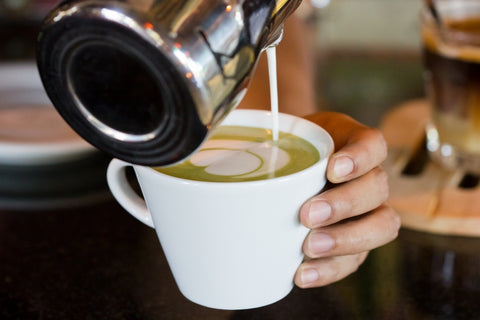When made well using Japanese Organic Ceremonial Grade Matcha, Matcha can taste like a concoction of fresh green vegetables, young bamboo, chlorophyll, and raw sugar. Unique isn’t it?
There are those who would say that this taste is perfect. It is how a healthy beverage such as Matcha should taste like.
(Learn how to make Matcha in the traditional style.)
Don’t worry. Like every other food and beverage in the world, there are taste enhancers for Matcha as well. Milk is one of them.

Add milk to Matcha and make it a latte, see how the taste transforms. You don’t have to use dairy (good news for vegans and those allergic to dairy). You can use soya milk instead.
But when using milk, make sure to use Culinary Grade Matcha rather than ceremonial grade. The reason is, Culinary Grade is more suited to go with milk and makes a better latte than Ceremonial Grade Matcha.
Matcha goes great with cream cheese, yoghurt, and all dairy. So pair it up with dairy if you want to enjoy Matcha with the vegetal taste minimised.
Chocolate and Matcha go very well with each other. Add Matcha in your chocolate truffles, molten cakes, ice creams, cookies, parfaits and mousses for a wonderful blend of flavour and finish. You can add Matcha in your hot chocolate too.
As for savoury dishes, Matcha can be a great finishing salt. Just throw in some regular salt and Matcha and mix well. Sprinkle it over scrambled eggs, salads, and tofu and enjoy!
In Japan, dentists prescribe patients to use Matcha as a mouthwash because it has plaque-fighting properties. So, when you drink Matcha, don’t wash your mouth immediately after. Keep the Matcha in your mouth for a while. Let it linger.
You will feel a fresh, grassy flavour which will make you want more. That’s the magic of Matcha. Once you’ve liked it, you’ll keep falling in love with it time and again.
|
Comments will be approved before showing up.